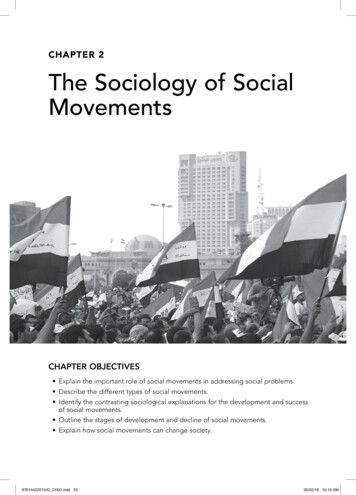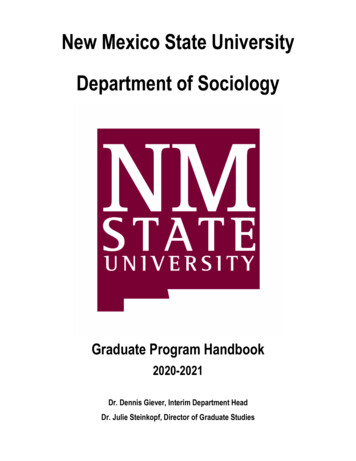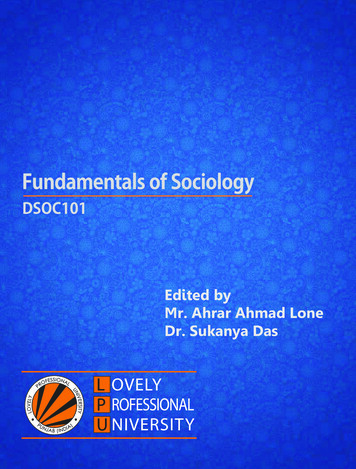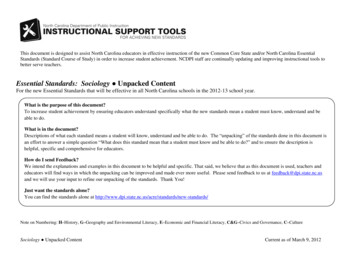
Transcription
CHAPTER 2The Sociology of SocialMovementsCHAPTER OBJECTIVES Explain the important role of social movements in addressing social problems. Describe the different types of social movements. Identify the contrasting sociological explanations for the development and successof social movements. Outline the stages of development and decline of social movements. Explain how social movements can change society.9781442221543 CH02.indd 2505/02/19 10:10 AM
26 \ CHAPTER 2AFTER EARNING A BS IN COMPUTER ENGINEERING from Cairo University and an MBA in marketing and finance from the AmericanUniversity of Egypt, Wael Ghonim became head of marketing forGoogle Middle East and North Africa. Although he had a careerwith Google, Ghonim’s aspiration was to liberate his country fromHosni Mubarak’s dictatorship and bring democracy to Egypt. Waelbecame a cyber activist and worked on prodemocracy websites. Hecreated a Facebook page in 2010 called “We are all Khaled Said,”named after a young businessman who police dragged from anInternet café and beat to death after Said exposed police corruptiononline. Through the posting of videos, photos, and news stories,the Facebook page rapidly became one of Egypt’s most popularactivist social media outlets, with hundreds of thousands of followers(BBC 2011, 2014; CBS News 2011).An uprising in nearby Tunisia began in December 2010 andforced out its corrupt leader on January 14, 2011. This inspiredthe thirty-year-old Ghonim to launch Egypt’s own revolution. Herequested through the Facebook page that all of his followerstell as many people as possible to stage protests for democracyand against tyranny, corruption, torture, and unemployment onJanuary 25, 2011. Hundreds of thousands turned out for the protests in Cairo, Alexandria, and other cities, prompting the regime’ssecurity forces to seize Ghonim. On January 27, the governmenttried to stop the growing revolution by shutting down the Internet.Google and many other organizations and individuals demandedGhonim’s release. He was set free after twelve days and emergedas a heroic symbol of the revolutionary struggle. For weeks thecountry was in turmoil as police tried to evict protestors from keyareas of major cities, but popular momentum for change provedunstoppable. On February 9, hundreds of thousands of w orkerswent on strike around the country, and on the 11th Mubarak wasforced to resign, ending his thirty-year reign. Time magazine recognized Ghonim as one of the one hundred most influentialpersons of 2011 (Time 2013).Later developments showed that although the events of Januaryand February 2011 ended one dictatorship, they did not achievedemocracy in Egypt. The revolution for democracy and social justice in that nation and others around the world continues, but WaelGhonim’s actions demonstrate how one courageous individual canplay a key role in sparking a massive social movement to address socialproblems.As described in Chapter 1, the sociological imagination explains therole of social forces in our lives. When people believe that social forcescause a social problem, they often organize a collective effort calleda social movement to do something about it. This chapter exploreswhat social movements are, why and how they occur, and their stagesof development, as well as their effectiveness in bringing about socialchange.9781442221543 CH02.indd 2605/02/19 10:10 AM
The Sociology of Social Movements / 27WHAT IS A SOCIAL MOVEMENT?As you learned in the last chapter, a social problem exists when thereis widespread belief that a condition or pattern of behavior is harmful.A social movement is a persistent and organized effort involving themobilization of large numbers of people to work together to either bringabout what they believe to be beneficial social change or resist or reversewhat they believe to be harmful social change. Social movements areamong the most dramatic events the world has ever known. The UnitedStates has experienced great movements such as the abolitionist movement to end slavery in the nineteenth century, the women’s suffragemovement to win the vote for women in the nineteenth and early twentieth centuries, and the civil rights movement in the 1950s and 1960sto end racial discrimination. Along with certain national election campaigns, social movements have become the most important collectiveforce for bringing about change in the country’s history.Social movements can be classified in a number of ways. One canfirst consider whether the movement intends to bring about or resistchange. An innovative (liberal) movement intends to introducesomething new with regard to culture, patterns of behavior, policies,or institutions. For example, a liberal movement exists to legalize marijuana. A conservative movement has the goal of maintaining thingsthe way they are (resisting change), such as the movement to preventlegalization of marijuana where it remains illegal. A reactionary movement seeks to resurrect cultural elements, patterns of behavior, or institutions of the past (“bring back the good old days”). An example wouldbe a movement that wants to return to banning same-sex marriage.Movements can also be classified in terms of which aspects of society are targeted for change. Is change sought in patterns of behavior,culture, policies, or institutions? Are the changes meant to affect everyone, or only a particular group of people? A reform movement callsfor change in patterns of behavior, culture, and/or policy, but does nottry to replace entire social institutions. Supporters of reform movementsappeal to policymakers, attempt to elect candidates, and sometimesbring cases before courts to achieve their goals. Movements involvingcivil rights, women’s rights, sexual orientation, and the rights of peoplewith disabilities all call for acceptance by the larger culture to ensureequal access to all social institutions but do not aim to replace them.Antiwar and environmental movements are also considered reformmovements because they call for changes in government policy ratherthan sweeping institutional change.A revolutionary movement in contrast, aims to bring about greatstructural change by replacing one or more major social institutions. Inthe eighteenth century, the American Revolution succeeded in changingthe political system of the original thirteen colonies by freeing colonistsfrom British monarchical control and creating a democratic form ofgovernment. In the late eighteenth century and early nineteenth century,the French Revolution ended a monarchy and established a republic.More contemporary examples of successful revolutions include the 1979Iranian Revolution that replaced a monarchy with a fundamentalistIslamic republic, the revolutions that swept away one-party political9781442221543 CH02.indd 27social movement Apersistent and organizedeffort involving themobilization of largenumbers of people to worktogether to either bringabout what they believe tobe beneficial social changeor resist or reverse whatthey believe to be harmfulsocial change.innovative (liberal)movement A socialmovement that intends tointroduce something newwith regard to c ulture, patterns of behavior, policies, or institutions.conservativemovement A socialmovement with the goal ofmaintaining things the waythey are.reactionarymovement A socialmovement that seeks toresurrect cultural elements,patterns of behavior, orinstitutions of the past.reform movement Asocial movement that callsfor changes in patternsof behavior, culture, and/or policy, but does nottry to replace entire socialinstitutions.revolutionarymovement A socialmovement that aimsto bring about greatstructural change byreplacing one or moremajor social institutions.05/02/19 10:10 AM
28 \ CHAPTER 2identity movementA social movement aimedat creating a new identityfor an oppressed groupthat provides a sense ofempowerment, pride,self-confidence, andequality.new socialmovements Socialmovements that aroseduring the second half ofthe twentieth century andare concerned with moraland quality-of-life issuesand the establishment ofnew collective identities.9781442221543 CH02.indd 28systems in Eastern Europe and the former Soviet Union from 1989 to1991, and the anti-apartheid movement in South Africa that ended thesystem of white political domination there in 1994. Even more recently,the 1996–2008 Nepalese Revolution replaced a monarchy with democracy, and the Arab uprisings (collectively called the Arab Awakening orArab Spring), which began in Tunisia on December 17, 2010, changedthe forms of government in Tunisia, Egypt, and Libya, and may affecteven more Arab societies in the coming years.Social movements can also be classified in other ways. The majorgoal of an identity movement is to spread understanding of mechanisms of domination, including cultural elements such as oppressivelanguage, to destroy debilitating stereotypes, ways of thinking, and talkingthat are “the means and products of group subordination” (Gill andDeFronzo 2009:212). These movements attempt to create a new identityfor the oppressed group “that provides a sense of empowerment, pride,self- confidence and equality” and also actively confront “the larger public’s norms, beliefs, behaviors, and ways of thinking” (Gill and DeFronzo2009:212). Identity movements develop among persons who perceivethemselves to be the target of discrimination based on an ascribed characteristic such as race, nationality, physical characteristics, gender, sexualorientation, or other fixed traits. For example, the feminist movementattacks the traditional view of women as lacking the intelligence, will,emotional stability, or toughness to successfully participate in all areas oflife by focusing attention on women who have made great achievementsin politics, science, and business. This movement also promotes traitstraditionally associated with women, such as compassion and cooperativeness, as crucial to the well-being of society. The purpose of the feministmovement is to provide all women with psychological empowerment andpositive identities, and to replace stereotypes that limit their roles or definethem as inferior with a global conception of women as equal to men.Numerous factors can give rise to identity movements, including“exposure to concepts of freedom and liberation that were intendedfor the benefit of other groups, but have direct liberation implicationsto the members of another subordinated group” (Gill and DeFronzo2009:212). Although reform movements can be clearly differentiatedfrom revolutionary movements, other ways of classifying social movements are not mutually exclusive and can overlap. Reform movementsto expand the opportunities of certain categories of people and revolutionary movements to free whole populations from foreign control arealso to some extent identity movements because of their efforts to beneficially change the cultural identities of disadvantaged groups.Some sociologists believe that, in the first half of the twentieth century, social movements in the most technologically advanced societiescentered on economic goals. These dealt mainly with the redistribution of wealth and income and were based primarily on the industrialand urban work forces. In the second half, there was a perceived shiftto identity movements and movements focusing on government policies. These new social movements were concerned with moral andquality-of-life issues and the establishment of new collective identities. Examples of new social movements include peace movements (likethe anti–Vietnam War Movement of the 1960s and early 1970s) and05/02/19 10:10 AM
The Sociology of Social Movements / 29movements focusing on the environment, women’s rights, gay rights,and animal rights. Critics claim that this division is artificial, becausemovements concerned with moral and quality-of-life issues coexistedwith workers’ labor movements during the period of industrialization(Pichardo 1997), and new social movements often have economic aswell as moral and identity goals.Certain movements, sometimes called alternative movements,aim to change a single type of behavior. For example, the temperancemovement of the nineteenth and early twentieth centuries, similar infocus to today’s antidrug movement, tried to convince people not todrink alcohol because of suspected links to child and spousal abuse,other violent crimes, and social ills. Another example is an abstinencemovement. Abstinence movements such as True Love Waits advocatesexual relations only after marriage. Redemptive movements intendto bring about a more total transformation of the individual by encouraging people to adopt a new moral-religious outlook that will affect awide range of personal behaviors. Examples include religious revivalistor fundamentalist movements that demand a deeper demonstrationof commitment to the faith. Transnational movements are active inmore than one country. Examples include the women’s, environmental,and human rights movements, and movements promoting democracy.See table 2.1 for a summary of the different types of social movements,along with examples of each. It is important to note that some movements are more than one type. For example, the feminist movementhas aspects that permit it to be classified as an innovative (liberal)movement, a reform movement, an identity movement, a new socialmovement, and a transnational movement.Student Participation in Movements for SocialChangeStudent activism ranges from protests against university administrationsto mobilizations that have contributed to the downfall of governments.Many students, brimming with idealism, have initiated social movements or joined existing ones. The Social Movements box describes animportant social movement action that began with a sit-in at a lunchcounter by four college students in 1960. In the years that followed, hundreds of thousands of students became active in the civil rights movement, as well as the antiwar, women’s, environmental, and gay rightsmovements. Today, students are involved in movements fighting forsocial justice and human rights and participating in activist groups, suchas the new Students for a Democratic Society, successor to the massiveVietnam War-era student organization of the same name.As noted in the first chapter, one issue spurring youth to initiateprotests is the increasing cost of higher education. In 2011, studentloan debt reached about one trillion dollars and was estimated to begreater than all combined credit card debt in the United States (Cauchon 2011). This trend continued into 2018 when student debt reached 1.5 trillion owed by 44.2 million persons (Friedman 2018). In reactionto enormous tuition hikes, thousands of students enrolled in schoolsin the California State University system have participated in massive9781442221543 CH02.indd 29alternativemovements Socialmovements that aim tochange a single type ofbehavior.redemptivemovements Socialmovements that encouragepeople to adopt a newmoral-religious outlookthat will affect a widerange of personalbehaviors.transnational movements Social movementsactive in more than onecountry.05/02/19 10:10 AM
30 \ CHAPTER 2TABLE 2.1 Types of Social MovementsType of MovementGoalsExamplesInnovative (Liberal)Introduce new cultural elements, patterns ofinteraction, policy, or institutionsLegalize marijuana movementConservativeMaintain things the way they areKeep marijuana illegal movementReactionaryBring back old cultural elements, patterns ofbehavior, policy, or institutionsMovement opposing same-sexmarriageReformChange cultural elements, patterns of behavior,and/or policy, but do not replace institutionsU.S. civil rights movementRevolutionaryBring about great structural change by replacing one or more major social institutionsAmerican Revolution, FrenchRevolutionIdentityCreate positive cultural and personal identitiesfor members of groups that have been thetarget of prejudice and discriminationGay rights movementNew socialAchieve moral, quality-of-life, self- actualization, and othernoneconomic goalsAnti–Vietnam War movement,environmental movementAlternativeChange one specific type of behaviorTemperance movement, abstinence movementRedemptiveTotal moral change of individuals affectingmultiple behaviorsReligious fundamentalist movementTransnationalAchieve aims in more than one countryHuman rights movementprotest demonstrations beginning in the fall of 2009. Angus Johnston,a history professor at the City University of New York who studiesstudent activism, estimated that at least 160 student protests occurredin the United States during the 2014 fall semester alone, mostly involving issues related to sexual assault and sexism on campus, university governance and student rights, and tuition and funding (Johnston2014; Wong 2015). UCLA’s Higher Education Research Institute (2016)reported that in its Fall 2015 survey of 141,189 first-year full-timestudents entering four-year colleges and universities across the UnitedStates, about 9 percent said that there was a “very good chance” theywould participate in student demonstrations and protests while in college. This was the highest percentage in the annual survey’s fifty-yearhistory. Those expecting to participate varied from about 6 percent ofNative American and Asian students to 7 percent of white, 10 percent9781442221543 CH02.indd 3005/02/19 10:10 AM
The Sociology of Social Movements / 31Social movement activistsengaged in a protestdemonstrationof Latino and 16 percent of black students. The trend toward increasingU.S. student activism appeared to continue (Smith 2017).Internationally, students are active in social movements inmany countries. The Internet, cell phones, and social media have provided new means for reform and revolutionary ideas to spreadand inspire millions, and for people to organize and coordinatetheir actions. This was clearly demonstrated in the protests thatbroke out in Arab nations beginning in December 2010, describedin part in this chapter’s introduction. Since then students have usedsocial media to organize other major protests, including Hong Kong students’ huge prodemocracy demonstrations in 2014 (Epatko andDaly 2014; McKirdy 2017), and many protests in the United States(Curwen, Song, and Gordon 2015). Young people will continue toplay a central role in prodemocracy and human rights movementsaround the world.Here are several online resources for learning more about currentstudent movements in the United States:United States Student Associationhttp://www.usstudents.org/work/debt/The American Association of University Womenhttp://www.aauw.org/Youth Activism s/Nation Topics – Student -movements#axzz2cqinUdKOStudents for a Democratic Societyhttp://www.newsds.org/9781442221543 CH02.indd 3105/02/19 10:10 AM
32 \ CHAPTER 2Social Movements: A Social Movement Action Originating ata Lunch CounterLunch counter sit-in at Woolworth’s store,Greensboro, North CarolinaOn February 1, 1960, four African Americanfreshmen attending the Agricultural and Technical University of North Carolina – JosephMcNeil, Franklin McCain, Ezell Blair Jr. (wholater changed his name to Jibreel Khazan),and David Richmond – were inspired byearlier protests against racist segregationistpolicies to sit down at the whites-only lunchcounter at a Woolworth’s store in Greensboro,North Carolina. Although the staff refused toserve them, they refused to leave. Hundredsof students participated in lunch countersit-ins over the next few days, not just inGreensboro, but in other cities and states aswell. This launched a boycott of stores withservice segregation policies. Responding toeconomic losses, Woolworth’s desegregatedits entire national chain of stores the following July, an important victory for the growingcivil rights movement.Ask yourself:1. What social movements are students/student groups on your campus currentlyinvolved in?2. What movement-related actions or activities have students engaged inrecently?3. To what extent are the students involvedin a movement on your campus linkedto a national or transnational social movement?WHY DO SOCIAL MOVEMENTS BEGIN?Because social movements have played such important roles in shaping human history, social scientists have studied them and come upwith a number of explanations for why they develop. One approachis to explain why people are or become discontented with a particularcondition or pattern of behavior. It is easy to understand why someevents provoke widespread anger. For example, if for some reason allof the public school teachers in California were suddenly subjected toa 25 percent cut in pay, you would expect that most California teachers would be outraged and engage in some form of public protest. It’sharder to predict whether other, comparable social situations will produce widespread outrage. For example, the average salary for publicschool teachers in Indiana is about 30 percent less than the Californiaaverage, but there have not been any major protests by Indiana teachers about their inferior salaries (Herron 2018; Will 2018). Why not?A number of factors help determine why people react (or don’t react).One major type of explanation is deprivation theory, of which thereare two forms.9781442221543 CH02.indd 3205/02/19 10:10 AM
The Sociology of Social Movements / 33Absolute Deprivation and Relative DeprivationTheoriesAccording to absolute deprivation theory, social movements developwhen people are unable to obtain adequate food, shelter, or other basicneeds. However, history shows that people living in poverty over aperiod of generations develop the cultural outlook that their situation isfated and unchangeable. Similarly, the existence of wide gaps in wealthlevels of groups in a society does not seem sufficient to bring aboutsocial movements. Social movements, including revolutionary movements, appear to develop not just as a result of deprivation or inequalitybut because of expectations and moral beliefs concerning fairness andsocial justice (DeFronzo 2015; Fullerton 2006). In other words, livingconditions or political limitations only become intolerable when peoplecome to view them as unacceptable relative to how they think thingsshould be. Gurr (1970:46–56) describes three ways this view, calledr elative deprivation theory, can develop:1. Decremental deprivation. Decremental deprivation involves a rapiddrop in living standards caused by an event such as a sudden severeeconomic downturn. People feel deprived relative to their formerliving standards. For example, after the Great Depression began in1929, the United States experienced a great surge in participationin the labor movement; more workers joined labor unions in the1930s than ever before in the nation’s history. The new economicand political power of the great labor unions, such as the UnitedAuto Workers and the International Brotherhood of Teamsters,won higher wages, health insurance, pensions, and other benefitsfrom employers, which helped raise millions of workers into themiddle class.2. Progressive deprivation. According to a study of economic trendspreceding several major revolutions (Davies 1962), progressivedeprivation occurs when a society experiences a prolonged periodof economic progress and improved living standards followed by aperiod of sharp decline. Since people expect things to keep gettingbetter as they had in previous years, a wide gap develops betweenexpectations and worsening conditions. Both the American Revolution and the Russian Revolution of 1917 fit this pattern.3. Aspirational deprivation. Aspirational deprivation occurs whenpeople gain new information convincing them that their livingconditions are unacceptable and can be changed, causing discontent to rise and support for social movements to increase. Forexample, in the 1960s and 70s many younger Catholic priests andnuns in Latin American countries adopted liberation theology(Berryman 1987), a social justice orientation holding that clergyshould confront and criticize unjust social conditions, includingpoverty and inequality of opportunity, in addition to dealing withspiritual needs. Clergy informed their impoverished parishioners that poverty was not the result of God’s will but caused bythe selfishness and greed of certain people, and that these unjust9781442221543 CH02.indd 33absolute deprivationtheory The idea thatsocial movements developwhen people are unableto obtain adequate food,shelter, or other basicneeds.relative deprivationtheory The idea thatliving conditions orpolitical limitations onlybecome intolerable whenpeople come to view themas unacceptable relativeto their conception ofthe way they think thingsshould be.05/02/19 10:10 AM
34 \ CHAPTER 2conditions could and should be changed through group action.In response, many parishioners organized protests and even created social movements to demand change. When these effortswere repressed, some turned to armed revolutionary struggle, asin the successful revolution in Nicaragua in 1979 portrayed in asomewhat fictionalized fashion in the movie Under Fire.People may also experience relative deprivation when they witness acondition or a pattern of behavior that they find unacceptable in termsof deeply held personal moral standards. This helps explain why manypeople participate in movements even though they do not personallysuffer from the conditions they want to change. Moral relative deprivation explains why many college students participate in social movementsdealing with issues that may be remote from their personal experiences(Gill and DeFronzo 2009:205), as in campus mobilizations against SouthAfrican apartheid in the 1980s and early 1990s. In that movement theimmediate aim was to get colleges to stop investing in South Africa untilNelson Mandela, the leader of the African National Congress, was freedfrom prison and democratic elections were held. A more recent exampleis the student movement against sweatshops (see the Social Movementsfeature).Social Movements: The Student Movement against SweatshopsStudents protest against sweatshops9781442221543 CH02.indd 34The US anti-sweatshop movement is one ofthe largest American student movements sincecampuses mobilized in the 1980s and early1990s to force an end to apartheid in SouthAfrica. The elimination of sweatshops is farmore difficult because sending jobs to othernations where workers’ wages are much lowerhas become an integral part of the global economic system. Sweatshops are also a way forbusiness interests to weaken labor unions andlimit or lower American workers’ wages.A sweatshop is essentially any businessor manufacturing setting in which workersare very poorly paid or forced to work underharsh or unsafe conditions. Corporations in theUnited States and other countries obtain products from factories in developing countries inorder to increase profits. Sweatshops have alsooperated much closer to home. Some U.S.businesses hire illegal immigrants desperatefor any kind of job and afraid to complain tolegal authorities about abusive conditions.05/02/19 10:10 AM
The Sociology of Social Movements / 35Social Movements (continued )The vast majority of the price of productsrelying on sweatshop labor goes to the store,advertising, materials, shipping, and the contractor employing the workers. For example,according to the Asia Times (Guerin 2006),labor costs in Indonesia are only about 6 percent of production costs, so if the cost ofmaking a dress is 50, the worker who madeit receives 3. If the dress is sold at storesin the United States for 100, doubling theworker’s wage would only increase the American consumer’s cost to 103! This seeminglypaltry sum would make a huge difference forthe Indonesian worker, but the unregulatedmarket is continually under pressure to minimize labor costs rather than show concernfor worker welfare.Since it is impractical to organize workersat the tens of thousands of sweatshops indozens of developing countries around theworld, or even at the hundreds of sweatshopsin American cities, student activists, includingthose in the United Students Against Sweatshops (2017; Dreier 2001; Featherstone, 2002)movement, have instead focused on educating consumers in the United States aboutsweatshops and what they can do aboutthem. This includes refusal to buy productsfrom corporations that utilize sweatshops andcampus demonstrations to convince collegeofficials to stop selling the rights for collegelogos to clothing manufacturers that rely onsweatshops. The anti-sweatshop movementis also working with labor unions in the UnitedStates, as hundreds of thousands of American workers in the garment industry havelost their jobs due to this type of corporateoutsourcing, and millions have been forcedto settle for lower wages or benefits underthe threat that their jobs could be shipped toanother part of the world.Anti-sweatshop movement activists wantU.S. companies, colleges, and governmentagencies to agree to and enforce a policy mandating that workers are paid livablewages and are permitted to form labor unionsif they wish, and that companies provide safework places visited regularly by independentinspectors.For more information, visit United Students Against Sweatshops: http://usas.org/.What are your thoughts?1. Do you think that companies that usesweatshops should be prevented fromselling sweatshop products in the UnitedStates? Why or why not?2. Do you think that stores should be prevented from selling sweatshop products?Why or why not?Resource Mobilization TheoryAccording to resource mobilization theory, people motivated to create a social movement must have access to necessary resources to succeed (Jenkins 1983). Useful resources include funding, effective leaders,and access to social networks through which new participants can berecruited. Other beneficial resources can be the suppor
maintaining things the way they are. reactionary movement A social movement that seeks to resurrect cultural elements, patterns of behavior, or institutions of the past. revolutionary movement A social movement that aims to bring about great structural change by replacing one or more major social institutions. reform movement A











